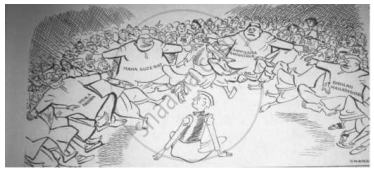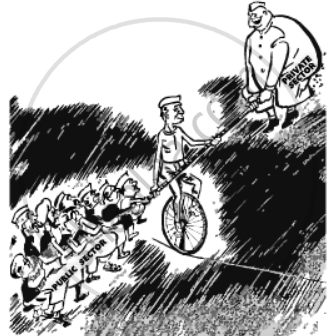Advertisements
Advertisements
Question
What were the major differences in the approach towards development at the time of Independence? Has the debate been resolved?
Solution
At the time of independence, development was about becoming more like the industrialised countries of the West, to be involved with the break down of traditional social structure as well as rise of capitalism and liberalism.
1. Modernisation referred to growth, material progress and scientific rationality.
2. India had two models of modern development at the time of independence into considerations to be adopted i.e. the liberal capitalist model like Europe and the US and the socialist model like the USSR.
3. A debate had been occurred regarding adoption of model of development as communists, socialists and Pt. J.L. Nehru supported the socialist model to reflect a broad consensus to be developed during national movement.
4. Above mentioned intentions cleared that the government made the priority to poverty alleviation alongwith social and economic redistribution.
5. At the same time, these leaders differed and debated:
- Industrialisation should be the preferred path or
- Agricultural development should take place or
- Rural poverty should be alleviated.
APPEARS IN
RELATED QUESTIONS
Match the following :
| (a) Charan Singh | (i) Industrialization |
| (b) PC Mahalanobis | (ii) Zoning |
| (c) Bihar Famine | (iii) farmers |
| (d) Verghese Kurien | (iv) Milk Cooperatives |
Which of the following is not a contributory factor for development?
The Socialist model of development was related to ______.
The Chairman of the National Development Council is ______.
Who among the following was the first chairman of Tripura State Planning Board?
Local Self Government intends to improve ______.
Who appoints the Vice-Chairperson of NITI Aayog?
Number of part-time members in NITI Aayog is ______.
Who amongst the following is the longest serving member of Tripura State Planning Board?
Engagement of local people in development project refers to ______.
The leader and the country that helped to reach the Tashkent agreement between India and Pakistan.
______ Policy has been adopted by NITI Aayog.
NITI Aayog serves as a think-tank to promote ______ federation where government acts as a ______ with the help of technology. Select the correct option.
Study the picture given below and answer the question that follows:

Choose the first state to be created due to linguistic demands after independence:
Observe the figure below and answer accordingly.

Which type of economic model was adopted by India?
Read the following paragraph and answer according.
NITI Aayog or National Institution for Transforming India Aayog is basically a policy think tank of Government of India and State Governments that replaces the 65-year old Planning Commission.
The Union Government of India had announced formation of NITI Aayog on 1st January, 2015. The body is composed of a CEO and a Vice Chairperson, to be appointed by the Prime Minister, in addition to some full-time members and two part-time members, while four Union Ministers would serve as ex-officio members.
Besides, there would be specific regional councils, while experts and specialists from various fields would be called as special invitees nominated by the Prime Ministers.
NITI Aayog will serve as a “think tank” of the government as a “directional and policy dynamo” and would provide both to the governments at the centre and in the states with strategic and technical advice on key policy matters including economic issues of national and international importance.
NITI Aayog will have regional councils to focus on developmental activities on specific areas and is patterned on the National Reforms Development Commission of China.
When was NITI Aayog formed?
Following are a few points given on the approach towards development at the time of Independence. Which of them is correct?
- The common perception of Development was becoming modernized which involved the breakdown of traditional social structure
- After independence India had two models of development one was Europe's and US's liberal capital model and the other USSR's socialist model.
- Many including the Communist Party of India and leaders like Nehru. were impressed by the Soviet model and very few favored the American models.
Which of the following is not a feature of Indian economic planning?
Which of the following option is correct?
Which of the following option is true in the context of the "Kerala Model"?
Which two model of development India had adopted on the eve of independence?
In which year was the NITI Aayog constituted?
Who among the following appoints the Vice Chairperson of NITI Aayog?
Which of the following statements about NITI Aayog are true?
- NITI Aayog acts as a think tank of the Union Government.
- NITI Aayog acts against terrorism.
- NITI Aayog acts in a spirit of cooperative federalism.
- NITI Aayog design strategic and long term policy and programme frameworks.
Which factor was responsible for discouraging research and development in the manufacturing sector?
The idea of planning in India was drawn from
- The Bombay Plan
- Experiences of the Soviet Bloc countries
- Gandhian vision of Society
- Demand by Peasant organizations
Which of the following statements about NITI Aayog are true?
- NITI Aayog acts as a “think tank” of the Union Government.
- NITI Aayog acts against terrorism.
- NITI Aayog acts in the spirit of cooperative federalism.
- NITI Aayog decides more roles for bigger states and smaller roles for smaller states.
Choose the correct option:
Which one of the following is not the objective of NITI Aayog?
Explain any two reasons for the formation of the NITI Aayog in place of the Planning Commission by the Union Government.
